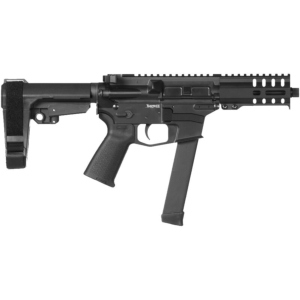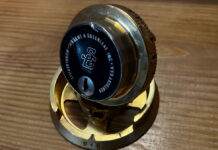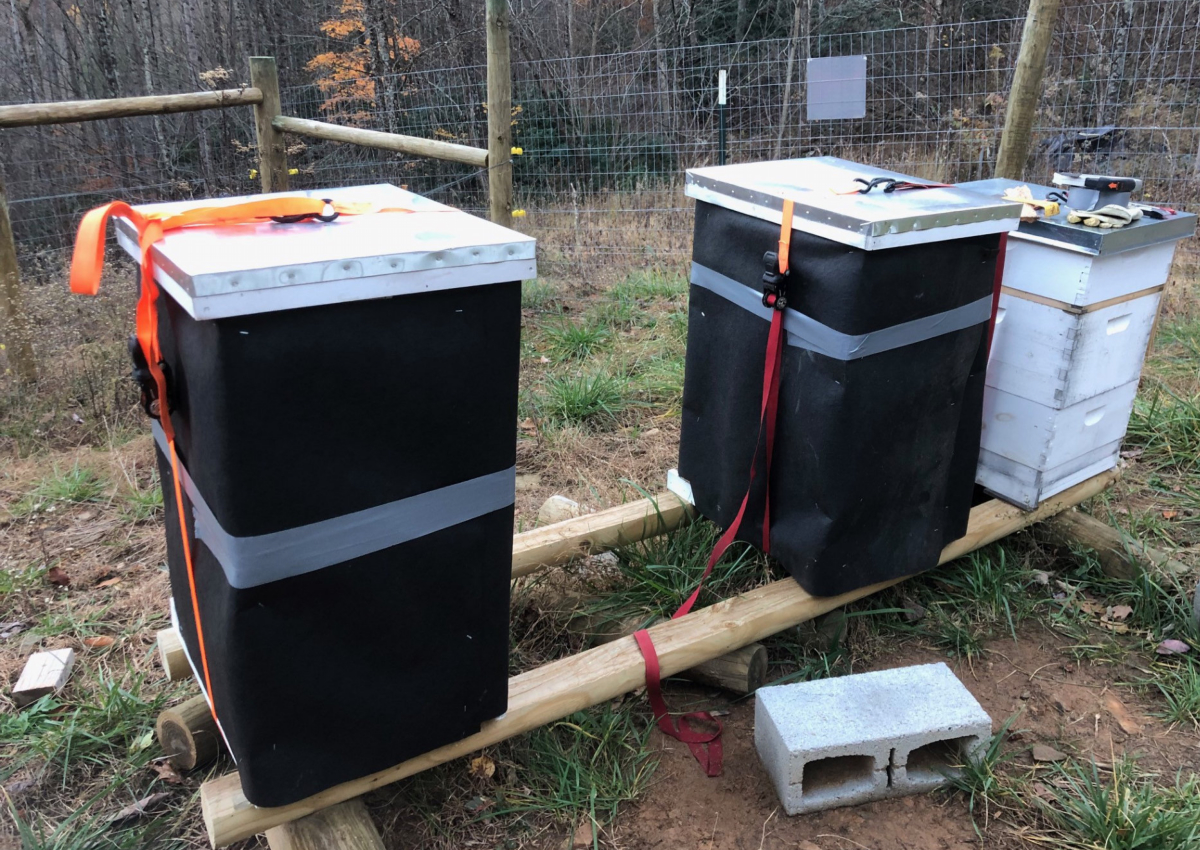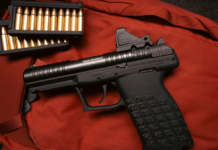One of the best things about ordering new firearms accessories is getting to install them and try them out. After getting the bees in good shape for another week, I took a break from homestead chores and did some shooting.
Weapons Mounted Light Review
First, I installed my new weapons-mounted light, and while it may be made in China, it’s not bad. I am referring to the Olight Sigurd Angled Foregrip with Built-in 1450 Lumen Rechargeable Tactical Flashlight. As you can see in the image above, this is an angled foregrip not unlike the Magpul AFG-2 with a built-in flashlight. Because the angled grip is legal to use on a pistol, I mounted it onto my AR-pistol with an 11.5-inch barrel. Here are my thoughts on this product are below.
Hot
This is a clever design. Too bad Magpul didn’t think of it, as I am not a huge fan of Olight. I had a product of theirs fail back in the teens and I haven’t bought any Olights since. I bought this one because at less than $100 it was not unreasonably priced (the AFG is $35 without a light), and I wanted to mount an angled foregrip on my pistol. This seemed like a good way to kill two birds with one stone and save both some real estate on the rail and some money.
The light is very bright and has a wide beam. On the downside, the brightness steps down after a couple minutes of continuous use and dim further as more time passes. This is done to keep the light from overheating. In real-world use, I don’t expect overheating will be a problem as I will use the light only intermittently. If you leave your light on for long, you are asking to become a target.
Not so Hot
On the downside, the rechargeable battery is sealed inside the foregrip. That’s bad because I can’t swap out a fully charged battery if it runs low. To recharge this light, you must use its cable and plug it into a USB port. I have plenty of USB chargers and ports, including a small portable battery pack, but in a pinch it is faster to use a spare 18650 or a couple onetime use CR123 batteries instead of taking more than three hours to recharge your light.
Olight uses a customized USB cord with a magnetic connector on the other. If I lose the cord, I am up the creek without a paddle—or a light. I bunched the cable up and crammed it into the weapons MOE pistol grip, which has an enclosed compartment. That’s an acceptable compromise, as long as I am not in a rush and remember to put it away.
Another negative: the on/off switch is not in an ideal position when my hand is resting naturally on the angled foregrip. It is too far forward. I can still reach it, but it is not intuitive or ergonomic.
Finally, the sales literature said the “Compatible with Picatinny and M-LOCK rails” (sic). However, it did not come with any way to mount to an M-LOK rail. I had to dig through my big box of AR15 accessories to find a section of Picatinny rail that would attach to my M-LOK rail. I would have been annoyed if I had to order one and wait for it to arrive.
Final Score

So far, I give this light three pickles on a scale of one to five. Keep in mind that I’ve used it once on the range and carried the gun and tried out the light while walking the dog. Not any kind of real-world test. For all I know, it could fail before I fire 300 rounds. At this point I consider this not a bad product, but it could be better. Maybe they will make a 2.0 version.
Heavy Duty Carry
The other day, I locked my gun in the console vault while I went into the post office. When I got home, I realized my gun was still in there. Because our ford is still washed out, I had parked down the mountain, and I didn’t want to run down there just to get my gun. So I went to my safe and got out my trusty Glock 23, which I had carried for 20 years.
The difference in weight between the Glock 23 and my new EDC Glock 48 was remarkable. And to think, in my younger years, I often carried the even larger Glock 22. (No wonder cops get back problems.) When you go to a lighter gun, you don’t notice the difference, but moving back to a heavier one? The difference is obvious. No wonder compact and subcompact guns are so popular. I probably should have moved to one years ago.
While sorting through my Glock gear, I found a conversion barrel from Lone Wolf that lets you shoot 9mm rounds from a .40 Glock 23. You can’t just stick a Glock 19 barrel in thre because the diameter of the barrel is different. So a conversion barrel is required. Although the frames are the same size, you also can’t put a Glock 23 barrel in a Glock 19 because the hole in the slide is too small so the barrel won’t fit.

I think a conversion barrel is a good item for Glock-owning preppers, especially those who have .40 caliber weapons. In a post-SHTF world, there will probably be far more 9mm ammo out there for salvaging or gleaning than .40. How handy to be able to shoot either one in the same gun simply by changing the barrel.
By installing this barrel in my Glock 23, I can also use the same 33 round magazines as my 9mm AR Pistol. That kind of interchangeability makes your loadout easier.
Shooting the PSA Micro Dagger
I gave my daughter a PSA Micro Dagger for Christmas and she shot it during her visit, but then left it with me because she didn’t have a gun safe and wasn’t sure her roommate would approve of having a gun in the house. That surprised and disappointed me. Another disappointment was that we experienced several failures-to-feed while shooting the weapon. Last week, I ran 65 rounds through it and it functioned fine.
Maybe this is because I cleaned and lubed it. Maybe it is because I have a tighter grip. In fact, I found I had to squeeze the heck out of it to keep the gun stable because its trigger is so much heavier than the aftermarket trigger I have in my Glock 48. As a result, I had to grip the gun tighter to isolate and use my trigger finger without squeezing my whole hand and sending the bullets low and left. You gotta hang on to these light polymer guns to control recoil, and striker-fired triggers just don’t compare to the clean break of a 1911 or a revolver in single action.
Has the failure-to-feed problem been resolved? No! 65 rounds is not a sufficient test. I want to run at least 200 or more rounds through it, and then let her run a couple hundred more though without a FTF before I trust it.
In Praise of Competition
I know many people consider shooting competitions to be games rather than training, but there is nothing like competition to hone certain skills, such as engaging multiple targets, learning how to shoot on the move, and shooting in different positions and from behind cover. For example, how often would you practice shooting an AR while using a curb as cover? Or shooting weakhand from behind a barricade. Competition made me practice those more than I would have otherwise.
One thing we did in training is clearing malfunctions. I can do a tap-rack-bang drill in my sleep. I’ve done it in a course of fire and not even remembered until afterwards when the RO said, “Nice tap, rack, bang. You barely lost any time.”
You want to practice your firearm skills until you can do basic things like reloading and clearance drills while blindfolded and walking in deep snow. Ok, perhaps a slight exaggeration, but you get the idea. In you are ambushed and have to respond, you are going to be operating on muscle-memory, so make sure your muscles have some memory and can do these basics without stopping to think it through. That takes repetition which requires training.
It’s one thing to hit the same target at the same distance, from the same stance every time. It’s a whole other world when the target is behind cover or moving at an unknown distance and you have to shoot from prone or behind cover, too. So mix up your training from time to time. Don’t just train on a standard range with a table in front of you.
And remember this about training: Amateurs practice until they get it right. Professionals practice until they can’t get it wrong.








Hey I want to known if you read and post comments. I’m not sure
..
JP
Yes, I do. Sometimes it takes a day or two as many are Spam and junk.
Comments are closed.